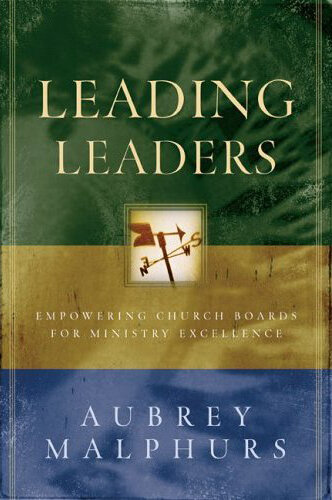Aubrey Malphurs, Leading Leaders: Empowering Church Boards for Ministry Excellence, A New Paradigm for Board Leadership. Baker, 2005.
Prequels:
Referenced in: Policy Governance Models for Church Leaders
LifeandLeadership.com Summary
This is the third in a series on leadership development by Aubrey Malphurs. The first was Being Leaders (2003), the second was co-authored by Will Mancini, Building Leaders (2004). The first volume looks at what it takes individually to lead effectively, with special applicability to the lead minister role. The second book discusses how to develop leaders at all levels within the congregation, both staff and volunteer. This volume looks more specifically at elder/board leadership.
Leading Leaders fills a unique niche in the literature on church leadership, how to train and develop “board” leadership in churches. Many who adopt a shepherding understanding of the elder role will find the “board” language too technical. Yet most elders, even those whose gifts are primarily in shepherding, still function as congregational overseers. Perhaps the most popular resource for board leadership is the Policy Governance Model by John and Miriam Carver. The value of this text by Malphurs is that he translates the Carver model into churchese.
Malphurs addresses the reality that about 90 percent of churches in America are led by lay governing boards no matter what polity (church government) they profess. However,
“though most boards are well intentioned, most have not been trained for their work and most have not thought through or fully understood what they’re doing. This lack of training and understanding means that most boards do not function well.” (12)
They are, as John Carver describes, “incompetent groups made up of competent people,” or “intelligent people tied up in trivia.” Malphurs quotes Carver,
“In my experience, most of what the majority of boards do either does not need to be done or is a waste of time when done by the board. Conversely, most of what boards need to do for strategic leadership is not done.”
Malphurs adds that “these are descriptions of boards in general, [but] my experience is that it’s the same or worse in the congregational world.” (14)
Malphurs writes to improve the situation. He offers a definition of board leadership: a gathering of two or more wise, spiritually qualified leaders who have been entrusted with authority to use their power to direct the affairs of the church.” (23-24) He also addresses the rationale for board leadership, board accountability and composition, spiritual characteristics of board member, the functions of board leadership, and how to conduct board meetings. He also provides an extensive description of the Carver policies approach and how to implement it. One chapter is on training board leaders.
Typical of Malphurs, the appendices (over 100 pages) are excellent. Some of these are duplicates of what may be found in the other two volumes:
- Board member audit
- Role of a board member’s spouse
- Policies governing the board
- Policies governing the senior pastor
- Policies governing the board-senior pastor relationship
- Mission statement
- Men’s and Women’s character assessments for leadership
- Board member covenant
- The church and power
- Sample policy statements and manuals from several churches
From the Publisher
The key to effective leadership in the vast majority of today’s churches lies as much with their governing boards as it does with their pastor. But many churches are lead by those who volunteer to chair committees because there is a need, yet they have no leadership training to speak of. How can well-meaning but sometimes ill-prepared lay people guide the path of a church body?
The secret lies in offering effective, practical training. Leadership expert Aubrey Malphurs provides this in Leading Leaders. Filling a gaping hole in leadership literature, Malphurs offers workable strategies to train laypeople to successfully lead their churches.
From the Back Cover
The key to effective leadership in today’s churches lies as much with their governing boards as it does with their pastors.
Many churches are led by volunteers who chair committees yet have little or no leadership training. Is it possible for well-meaning but often ill-prepared laypeople to guide a church body into Christ-honoring ministry?
The answer is yes, and the secret lies in offering church leaders effective, practical training. In Leading Leaders, Aubrey Malphurs provides workable strategies to train laypeople to successfully lead their churches. Covering such concerns as “Who is really leading the church?” and “What do church boards do?” this book provides not only practical evaluation tools, but a plan for developing a church board that can accomplish defined and vital goals.
Including fourteen appendices and helpful questionnaires, Leading Leaders builds on the well-received Being Leaders and Building Leaders. It is a practical guide to creating and maintaining a dynamic and effective church leadership team that is spiritually equipped and properly trained to lead the local body of Christ.
Aubrey Malphurs is professor of pastoral ministries at Dallas Theological Seminary. A nationally recognized expert on leadership issues, he is the author of more than fifteen books and the president of the Malphurs Group (www.malphursgroup.com), a training and consulting organization.
About the Author
Aubrey Malphurs is professor of pastoral ministries at Dallas Theological Seminary. He is also the author of over a dozen books, as well as president of the Malphurs Group, a church-consulting firm. He lives in Dallas, Texas.
***For additional information on this resource, including reviews, click the bookstore links. Check the reference at page top or the links below for resource guides on related topics.***
Other Ministry Resource Guides:
- Church Leadership and Renewal
- Elders, Plural-Elder Congregational Leadership
- Elders, Policy Governance Models
- Leadership
- Managing Volunteers
- Ministry Staff, Ministry Teams
See Resources on Over 100 Areas of Ministry Leadership:


